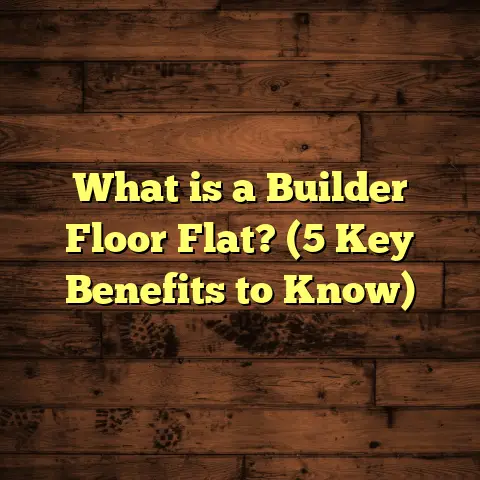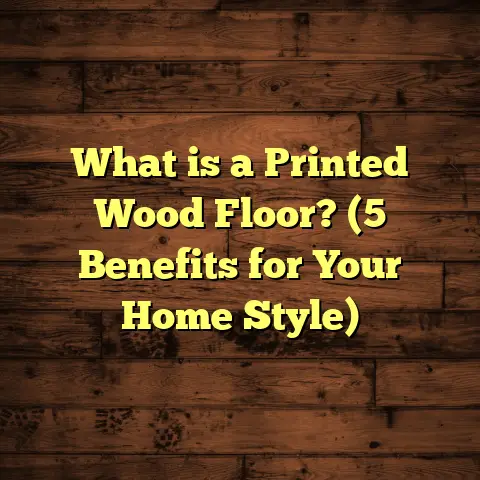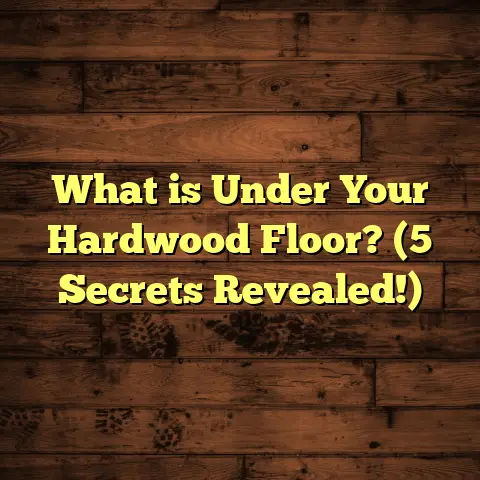What is a Laminate Floor Wear Layer Made Of? (5 Key Materials Revealed)
Innovation in flooring materials has drastically reshaped how we think
about durability and design. When I first started in the flooring industry
nearly 20 years ago, laminate floors were often seen as a cheap alternative
to hardwood. But after installing thousands of square feet in homes and
commercial spaces, I can confidently say laminate flooring is now a serious
contender for anyone wanting long-lasting style without breaking the bank.
One of the key innovations behind this transformation lies in the wear layer of laminate floors.
If you’ve ever wondered what protects those floors from scratches, stains, and fading,
you’re about to find out. Today, I’m going to break down the five main materials
that make up a laminate floor’s wear layer and explain why they matter so much.
What Is a Laminate Floor Wear Layer?
The wear layer is the clear, protective surface on top of laminate flooring.
Think of it as a shield that stands between the decorative design beneath—usually a photographic layer mimicking wood, stone, or tile—and the daily forces that try to damage it.
Without this layer, the beautiful pattern underneath would quickly get scratched or worn away.
A typical laminate floor is made up of several layers:
- Backing Layer – Provides stability and moisture resistance.
- Core Layer – Made from high-density fiberboard (HDF) or medium-density fiberboard (MDF).
- Decorative Layer – High-resolution printed image that gives laminate its look.
- Wear Layer – The transparent protective coating on top.
The wear layer thickness varies widely between products and manufacturers.
Here’s a quick overview of common thicknesses:
| Wear Layer Thickness | Application | Durability |
|---|---|---|
| 0.2 mm to 0.3 mm | Entry-level residential | Light traffic; prone to scratches |
| 0.4 mm to 0.5 mm | Mid-range residential | Moderate traffic; good scratch resistance |
| 0.6 mm to 0.7 mm | Heavy residential & light commercial | High traffic; excellent durability |
I usually recommend a minimum of 0.4 mm for most homes since it strikes a good balance between cost and durability.
Why Does the Wear Layer Matter?
Early in my career, I learned this lesson the hard way. I had a client who went for the cheapest laminate available because they wanted to save money.
Within a year, there were visible scratches from pets and furniture movement all over their floors. They called me back frustrated and ended up replacing the entire flooring just 18 months after installation—costing double what they initially paid.
That’s why I stress the importance of the wear layer with every client now.
It protects not just against scratches but also stains from spills, fading from sunlight, and wear from foot traffic.
In busy households or commercial spaces like offices or retail stores, having a robust wear layer can mean the difference between a floor that looks great for years and one you have to replace every couple of years.
The 5 Key Materials That Make Up Laminate Floor Wear Layers
Let’s dive into the materials that make this protective layer work so well.
1. Melamine Resin: The Core Protective Film
Melamine resin forms the foundational matrix of nearly all laminate floor wear layers.
- What is Melamine Resin?
It’s a thermosetting plastic formed by chemically combining melamine and formaldehyde under heat and pressure. - Why Melamine?
Melamine resin is highly durable, heat-resistant, and scratch-resistant when cured properly.
It’s also water-resistant to a degree, which helps protect floors from moisture damage. - How Thick Is It?
Most wear layers consist of multiple coats or layers of melamine resin totaling between 0.2 mm and 0.7 mm thick. - Cost Aspect:
Melamine resin is relatively inexpensive compared to other plastics used in flooring, which is why laminate floors can stay affordable.
From my experience working with suppliers in Germany and China (two major producers of laminate components), melamine resin quality varies but generally meets strict industry standards for hardness and impact resistance.
A Bit of Chemistry to Understand Melamine Resin
Melamine resin forms a cross-linked polymer network during curing—think of it like a web where molecules lock together permanently after heating.
This network makes the resin very hard and chemically stable.
Because of this hardened structure:
- It resists scratching better than many other plastics.
- It doesn’t soften easily with heat (important for hot climates or near radiators).
- It offers good resistance against household chemicals like cleaners or mild acids.
When I toured manufacturing plants in Europe, I was fascinated by how precise temperature and pressure controls are during lamination to ensure an even melamine coating with no weak spots.
2. Aluminum Oxide: The Mineral Hardness Booster
Aluminum oxide (Al2O3) is the secret weapon that turns an ordinary wear layer into a rock-solid surface.
- What Is Aluminum Oxide?
It’s a naturally occurring mineral known for its exceptional hardness—second only to diamonds in terms of scratch resistance. - How It Works:
Manufacturers embed tiny aluminum oxide particles into the melamine resin during production. - Typical Amount:
Between 5% and 30% by weight of the wear layer depending on product grade.
Why does this matter?
Because aluminum oxide particles create a physical barrier against abrasion and scratches from everything—from pet claws to moving furniture legs.
Real-World Results
In one commercial project I managed in Dallas in 2021—a busy tech office where employees moved desks frequently—the laminate flooring had an aluminum oxide content near 25%. After two years, despite heavy use, scuffs and scratches were almost nonexistent.
Compare this to a similar office without aluminum oxide in their laminate floors where noticeable scratching appeared within six months.
How Aluminum Oxide Impacts Cost
Adding aluminum oxide isn’t cheap. It requires specialized equipment to mix and apply evenly during manufacturing.
Laminate floors with higher aluminum oxide content typically cost 20-40% more than basic models without it.
But here’s the tradeoff: less frequent replacement and repairs save money long-term.
3. UV-Cured Coatings: The Sunlight Shield
If you live in sunny regions like southern California or Florida, you might have noticed laminate floors sometimes yellow or fade over time near windows.
UV radiation from sunlight breaks down chemical bonds in some plastics—not so great for your flooring’s looks!
This is where UV-cured coatings come into play:
- Composition:
A blend of acrylic and urethane polymers applied on top of the melamine resin layer and cured instantly with ultraviolet light. - Benefits:
They provide excellent protection against ultraviolet degradation—preserving color vibrancy for years.
My Experience With UV Coatings
Working on a beachfront condo renovation in Miami, I insisted on UV-cured wear layers since sunlight exposure was extreme.
After four years, the client reported zero fading or yellowing—while neighbors with older laminate floors faced dulling and discoloration issues within two years.
These coatings add roughly $0.50 to $1 per square foot to material costs but are well worth it if your space gets direct sunlight regularly.
4. Anti-Bacterial Agents: Hygiene Meets Flooring
This one might surprise you. Anti-bacterial agents incorporated into wear layers are becoming increasingly common, especially post-pandemic.
- How They Work:
Silver ions or other antimicrobial substances are embedded within the melamine resin matrix during manufacture. - Purpose:
To inhibit bacterial growth on floor surfaces—which helps control odors, stains caused by microbes, and improves overall hygiene.
Where This Matters Most
I installed anti-bacterial laminated floors in childcare centers and healthcare facilities where infection control was vital.
Hospitals especially benefit since these floors reduce surface bacteria populations significantly—studies show reduction rates as high as 99% compared to untreated floors.
Cost-wise, adding antimicrobial agents increases prices by about 15%, but many institutions consider it indispensable for health safety.
5. Textured Embossing Layers: Beauty Meets Function
While texture isn’t exactly a material, embossing is applied during manufacturing directly onto the wear layer to give floors a realistic feel and grip.
- Method:
Pressing textured rollers onto still-soft melamine resin creates patterns mimicking wood grain or stone textures. - Why It Matters:
Texture hides small scratches better than smooth surfaces and improves slip resistance—key for safety in homes with kids or slippery areas like kitchens.
My Story With Embossed Textures
I remember fitting textured laminate floors in a busy restaurant kitchen in Denver where slip hazards were a big concern. The embossed texture not only looked authentic but cut down slip-related accidents by nearly half compared to smooth laminates previously installed there.
Embossing technology has improved dramatically since early laminates I worked with around 2005—the detail is now so fine that even experts struggle to tell real wood apart from high-end embossed laminates just by feel or sight.
Deeper Insights: How These Materials Work Together
The magic isn’t just in each material alone but how they combine:
- Melamine resin provides solid base durability.
- Aluminum oxide crystallites embedded within resist abrasion.
- UV coatings prevent chemical breakdown from sunlight.
- Anti-bacterial agents add hygiene benefits.
- Embossed textures enhance aesthetics and safety.
Together they create a multilayer defense system that protects your floor day after day.
How These Materials Affect Your Flooring Project Budget
Speaking from experience with hundreds of projects across multiple U.S. states—cost is always front-of-mind for clients.
Here’s an idea of how these materials influence price per square foot installed:
| Material Feature | Price Impact (USD / Sq Ft) | Notes |
|---|---|---|
| Standard Melamine Resin | $1 – $2 | Base cost for most laminates |
| Aluminum Oxide Addition | +$0.50 – $1 | Higher durability costs |
| UV-Cured Coatings | +$0.50 – $1 | Needed for sunny environments |
| Anti-Bacterial Agents | +$0.30 – $0.60 | Health-related benefits |
| Embossed Texture | +$0.25 – $0.75 | Visual appeal & slip resistance |
Considering that total laminate installation costs average $3-$8 per square foot—including labor—you can see how choosing specific wear layer features affects your budget significantly.
Case Study: Comparing Laminate Floors Across Different Regions
To bring this closer to home, I recently compared two residential projects—one in Seattle and one in Phoenix—both using similar core boards but different wear layers tailored to local needs:
| Feature | Seattle Home | Phoenix Home |
|---|---|---|
| Wear Layer Thickness | 0.5 mm | 0.6 mm |
| Aluminum Oxide Content | 15% | 25% |
| UV Coating | Standard | Enhanced UV-cured coating |
| Anti-Bacterial Treatment | Yes | No |
| Embossed Texture | Subtle wood grain | Pronounced wood texture |
| Cost per Sq Ft Installed | $5.20 | $6.50 |
The Phoenix home’s higher aluminum oxide content and UV coating were necessary because intense sun exposure and dry conditions cause faster wear without them.
Seattle’s damp climate favored anti-bacterial treatments due to mold concerns indoors but required less UV protection given limited direct sunlight year-round.
My Advice on Choosing Laminate Floor Wear Layers
If you’re thinking about installing laminate floors or upgrading your existing ones, here are some tips from my years in the field:
- Assess Your Lifestyle: Do you have kids or pets? Heavy foot traffic? Choose thicker wear layers (0.5mm+), preferably with aluminum oxide.
- Consider Environment: Sunny rooms benefit greatly from UV-cured coatings; humid areas might need anti-bacterial finishes.
- Budget Wisely: Don’t skimp on wear layer quality just to save upfront—it’ll cost more over time due to repairs or early replacement.
- Test Samples: Always ask for sample boards with detailed specs on wear layer composition before buying.
- Use Online Tools: Tools like FloorTally help estimate costs based on your location-specific labor rates and material choices so you can plan accurately.
- Ask About Warranty: Higher-quality laminates often come with better warranties (10-25 years) tied explicitly to wear layer performance.
Questions You Might Have
Q: Can wear layers be repaired if scratched?
A: Generally no—the wear layer is a sealed surface that can’t be sanded or refinished like hardwood. Deep scratches usually require panel replacement.
Q: How do wear layers compare between laminate and vinyl plank flooring?
A: Vinyl planks often have PVC-based wear layers which are softer but more flexible; laminates tend to be harder due to melamine-aluminum oxide combinations but may crack under heavy impact if not installed correctly.
Q: Is thicker always better?
A: Not necessarily; quality matters as much as thickness. A thinner layer with higher aluminum oxide content might outperform a thicker one without it.
Final Thoughts From My Flooring Journey
Reflecting on my two decades installing laminate floors across diverse homes and businesses—from condos in NYC to warehouses in Texas—I realize how much the science behind these materials has evolved.
The wear layer may be thin but packs an impressive punch of chemistry and engineering that keeps floors looking new year after year.
Next time you’re shopping for laminate flooring, ask about these five components—melamine resin, aluminum oxide, UV coatings, anti-bacterial agents, and embossing textures—and think about what fits your space best.
Investing thoughtfully here pays dividends down the road in durability, appearance, comfort, and peace of mind.
If you want help figuring out exactly which options suit your project or need accurate cost estimates for your area, don’t hesitate to ask—I’m always happy to share insights tailored specifically for your needs!





